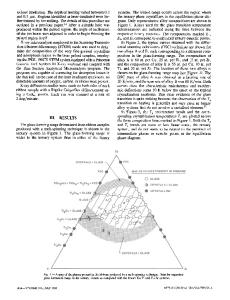Nonequilibrium phases in rapidly quenched Fe-Al-C ternary alloys
- PDF / 3,143,206 Bytes
- 6 Pages / 594 x 774 pts Page_size
- 89 Downloads / 375 Views
1. I N T R O D U C T I O N R E C E N T L Y , the present authors have presented a series of results concerning the effect of rapidquenching on the microstructures and mechanical properties of Fe-X-C (X = Cr, Mo and W) alloys containing ferrite forming elements.~-6 According to their results, various kinds of nonequilibrium phases such as amorphous, chi(x), epsilon(e), austenite('y) and cementite are formed in the Fe-X-C systems and among these phases, the amorphous- and austenite phases have a high level of strength as well as good ductility. In subsequent investigations, the present authors have examined the quenched structures of FeA1-C alloys, which belong to the same ferrite forming group, because the aluminum-containing alloys possess some engineering potential due to their economy as well as their ease of production. This paper deals with the composition ranges in which nonequilibrium phases form in the Fe-AI-C ternary system and the microstructures and crystal structures of their nonequilibrium phases. 2. E X P E R I M E N T A L P R O C E D U R E S The specimens used in the present work are Fe-A1-C ternary alloys. Mixtures o f pure metals (iron and aluminum), white cast iron and graphite were melted under an argon atmosphere in an induction furnace to prepare the test alloys. The melts were sucked up into A. INOUE is Research Assistant, The Research Institute for Iron, Steel and Other Metals, Tohoku University, Sendai 980, Japan. T. MINEMURA, formerly Graduate Student of Tohoku University, is now with Research Staff, Hitachi Research Laboratory, Hitachi Ltd., Hitachi 317, Japan. A. KITAMURA, formerly Graduate Student of Tohoku University, is now Judge, The Patent Bureau, Tokyo 100, Japan. T. MASUMOTO is Professor, The Research Institute for Iron, Steel and Other Metals, Tohoku University, Sendai 980, Japan. Manuscript submitted October 2, 1980.
quartz tubes of about 3 mm inner diam and solidified in the tubes. The compositions were determined by the weighed values in weight percent since the difference between weighed and chemically analyzed compositions is less than 0.2 wt pct for aluminum and 0.05 wt pct for carbon. From these alloys, long ribbons of about 1 m m width and 0.03 mm thickness were prepared as test samples by a single roller-type quenching apparatus. The a m o u n t of melted alloys per run was abo'.~ 1 ~ ~ d thc rc.t=.t".~n speed of the steel roll (200 m m in diam) was controlled at about 6000 rpm. As-quenched structures of the specimens were examined by transmission electron microscopy and X-ray diffraction using filtered Fe-Kot radiation. The hardness and strength of the specimens were measured by a Vickers microhardness tester with a 50 g load and an Instron-type tensile testing machine at a strain rate of 1.7 x 10-4Is, respectively.
3.RESULTS A N D DISCUSSION The compositional dependence of the as-quenched structures of the Fe-AI-C ternary alloys is shown in Fig. 1, wherein the open circles represent the alloy compositions that were examined. Single phase fields o f martensite(c~'), aus
Data Loading...











